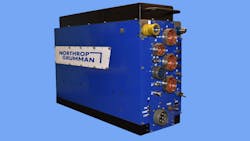Northrop Grumman Corp. is combining decades of signal-intelligence (SIGINT) experience with an open-standard design architecture to develop a new SIGINT sensor for the U.S. Air Force. Working under the Air Force’s Global High-altitude Open-system Sensor Technology (GHOST) program, Northrop Grumman is developing a prototype sensor with airborne and ground components that can perform high-altitude intelligence, surveillance, and reconnaissance (ISR). The sensor (see the figure) will be based on an open standards hardware and software architecture that can be scaled to an application, providing ISR functionality for both manned and unmanned Air Force vehicles.
Ben Davies, vice-president and general manager for networked information solutions at Northrop Grumman, said: “Leveraging our SAGE technology and 45 years of SIGINT mission expertise, our platform-agnostic GHOST sensor is a next-generation intelligence data collection and exploitation system.” The GHOST sensor is being designed to support rapid system enhancement while also featuring an agile architecture that can quickly be adopted to new threats. The SAGE (Space Awareness and Global Exploitation ) system is a multiple-sensor, multiple-mission system that merges data from many different sources on a continuous basis.
About the Author
Jack Browne
Technical Contributor
Jack Browne, Technical Contributor, has worked in technical publishing for over 30 years. He managed the content and production of three technical journals while at the American Institute of Physics, including Medical Physics and the Journal of Vacuum Science & Technology. He has been a Publisher and Editor for Penton Media, started the firm’s Wireless Symposium & Exhibition trade show in 1993, and currently serves as Technical Contributor for that company's Microwaves & RF magazine. Browne, who holds a BS in Mathematics from City College of New York and BA degrees in English and Philosophy from Fordham University, is a member of the IEEE.
